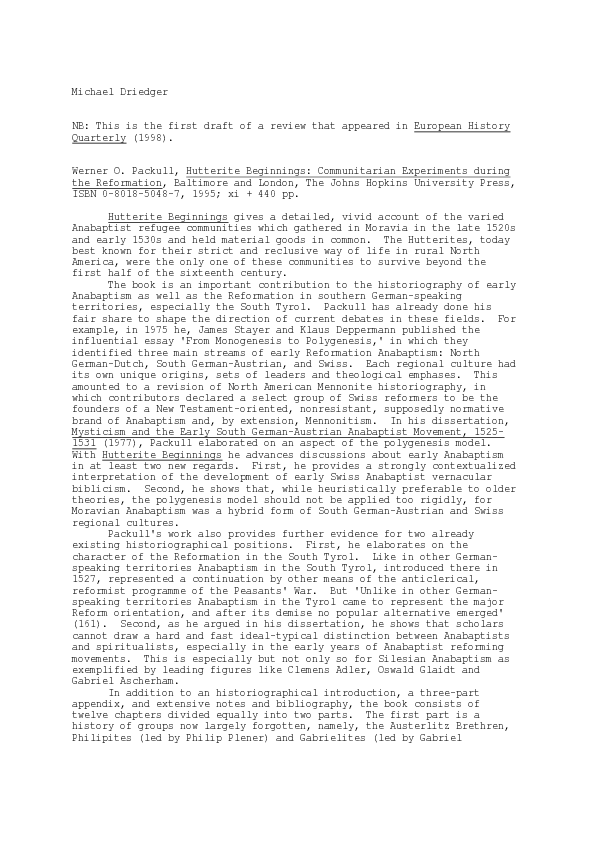Academia.edu no longer supports Internet Explorer.
To browse Academia.edu and the wider internet faster and more securely, please take a few seconds to upgrade your browser.
Review of Werner O. Packull, _Hutterite Beginnings: Communitarian Experiments during the Reformation_ (1995)
Review of Werner O. Packull, _Hutterite Beginnings: Communitarian Experiments during the Reformation_ (1995)
1998, European History Quarterly
Related Papers
Lived Religion and the Long Reformation in Northern Europe, eds. Sari Katajala-Peltomaa & Raisa Maria Toivo, Brill: Leiden
Appeal and Survival of Anabaptism in Early Modern Germany2017 •
1989 •
2012 •
This work evaluates the responses of four groups of “radicals” in the 16th and 17th centuries. Specifically, this is an investigation of if and why each group rejected the tithe tax, if and why they refused tithing at all, and how they differed in use of money for financing their leaders since they did not have the benefit of a government-levied tax. This paper looks at the earliest Swiss and German Anabaptists, the early Hutterites, the Levellers, and the Diggers. In each major section, each group’s thought is presented separately and comparatively evaluated. Master’s thesis. "Ms. Komasin. . . . showed great aptitude for high quality research for a thesis written under the direction of Professor Elsie Anne McKee, the Archibald Alexander Professor of Reformation Studies and the History of Worship. Entitled, 'Sixteenth and Seventeenth Century Reform and Dissent: Tithes and Payment of Leaders among Swiss/German Anabaptists, Hutterites, Levellers, and Diggers,' the thesis was awarded the Senior Fellowship in History prize by the Department of History and Ecumenics. The work was a significant study in how voluntary religious associations, independently of the tax supported state churches of the early Modern Period, and therefore bereft of ecclesiastically designated state funds, nevertheless managed in differing ways to provide for their leadership and activities In this sense, the Swiss/German Anabaptists are harbingers of the kind of voluntary and self-supporting charitable and religious organizations that are such a feature of the contemporary world. While working chiefly with English-language sources, Ms. Komasin's thesis made use of a number of primary sources from the English Levellers and Diggers who sojourned on the continent of Europe. In my judgment, Ms. Komasin's work indicates a high aptitude for scholarly research." - James F. Kay, Dean of Academic Affairs, Princeton Theological Seminary
A table outlining the dates of key events in the Radical Reformation takeover of Munster and the ensuing siege, conquest and punishment. [Supporting documentation for a PhD seminar presentation on the topic in Spring 2007 for "The Radical Reformation" taught by Rosalie Beck at Baylor University.]
Journal of Mennonite Studies
Toward a Definition of Sixteenth-Century Anabaptism: Twentieth-Century Historiography of the Radical Reformation1986 •
RELATED PAPERS
Community Heritage in the Arab World
Invoking Awneh Community Heritage in Palestine2022 •
FOR AN AMAZON FROM AMAZONIAN VIEWS: REFLECTIONS AND RESISTANCE (Atena Editora)
FOR AN AMAZON FROM AMAZONIAN VIEWS: REFLECTIONS AND RESISTANCE (Atena Editora)2024 •
Bioorganic & Medicinal Chemistry
Acyl-sulfamates target the essential glycerol-phosphate acyltransferase (PlsY) in Gram-positive bacteria2012 •
Nordic Journal of Working Life Studies
Working in the Same Sector, in the Same Organization and in the Same Occupation: Similarities and Differences Between Women and Men Physicians’ Work Climate and Health Complaints2015 •
2012 •
2018 •
Mathematics and Statistics
Qualitative Analysis of Food-Web Model through Diffusion-Driven Instability
 Michael D Driedger
Michael D Driedger